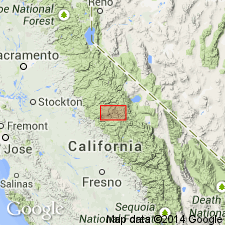
- Usage in publication:
-
- El Capitan granite*
- Modifications:
-
- Named
- Dominant lithology:
-
- Granite
- AAPG geologic province:
-
- Sierra Nevada province
Summary:
Named for El Capitan, Yosemite National Park because it forms greater part of El Capitan. [no type designated]. Included in informal western intrusive series. Most extensively developed biotite granite in region. Composed in large part of light-colored biotite granite of moderately coarse and in part obscurely porphyritic texture but along E margin it passes from porphyritic to nonporphyritic rock. Cut by all adjoining intrusive rocks except granodiorite of The Gateway and some gabbro and diorite that occur near lower end of valley. Map shows contacts with Taft granite and Sentinel granite. Is oldest biotite granite in region. [Probably Cretaceous age].
Source: GNU records (USGS DDS-6; Menlo GNULEX).
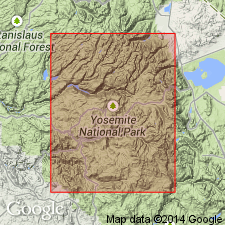
- Usage in publication:
-
- El Capitan granite*
- Modifications:
-
- Geochronologic dating
- AAPG geologic province:
-
- Sierra Nevada province
Summary:
K-Ar age of 92.2 Ma on El Capitan was obtained. El Capitan granite is younger than Gateway granodiorite (92.9 Ma) and older than Sentinel granodiorite (88.4 Ma).
Source: GNU records (USGS DDS-6; Menlo GNULEX).
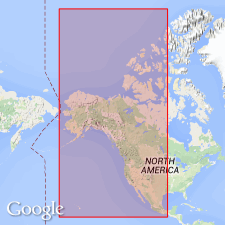
- Usage in publication:
-
- El Capitan granite*
- Modifications:
-
- Geochronologic dating
- AAPG geologic province:
-
- Sierra Nevada province
Summary:
Lead-alpha age on zircon of El Capitan granite yielded 94 Ma.
Source: GNU records (USGS DDS-6; Menlo GNULEX).
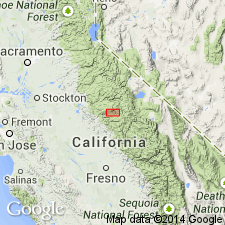
- Usage in publication:
-
- El Capitan Granite*
- Modifications:
-
- Age modified
- AAPG geologic province:
-
- Sierra Nevada province
Summary:
Age changed from Cretaceous(?) to Cretaceous based on potassium-argon determinations of 92.2 Ma (Curtis and others, 1958).
Source: GNU records (USGS DDS-6; Menlo GNULEX).
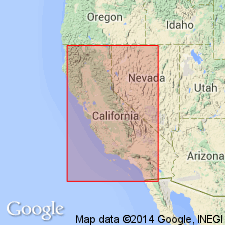
- Usage in publication:
-
- El Capitan Granite*
- Modifications:
-
- Geochronologic dating
- Age modified
- AAPG geologic province:
-
- Sierra Nevada province
Summary:
Included in Yosemite intrusive epoch. Whole rock specimens of biotite granite of El Capitan Granite yielded 136 Ma. Age changed from Cretaceous to Late Jurassic.
Source: GNU records (USGS DDS-6; Menlo GNULEX).
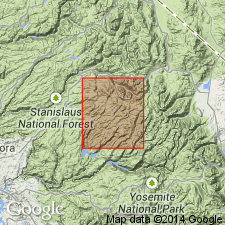
- Usage in publication:
-
- El Capitan Granite*
- Modifications:
-
- Areal extent
- AAPG geologic province:
-
- Sierra Nevada province
Summary:
Granitic rocks largely part of El Capitan Granite (Calkins, 1960) extend along south boundary of Emigrant Basin primitive area, southwest of Bigelow Peak in Pinecrest and Tower Peak 15-min quadrangles, east Tuolumne County, California.
Source: GNU records (USGS DDS-6; Menlo GNULEX).
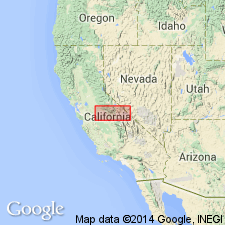
- Usage in publication:
-
- El Capitan Granite*
- Modifications:
-
- Geochronologic dating
- Age modified
- AAPG geologic province:
-
- Sierra Nevada province
Summary:
U-Pb ages on samples 25 and 26 from El Capitan Granite are 103 and 97 Ma. Sample 25 collected at roadside outcrop on HWY 41 on Turtleback Dome at W end of Yosemite Valley, Yosemite 15' quad, CA. Sample 26 collected at trailside outcrop near Chilnalna Falls, NE of Wawona, Yosemite 15' quad. Shown on simplified geologic map of central Sierra Nevada. Age changed to Early Cretaceous.
Source: GNU records (USGS DDS-6; Menlo GNULEX).
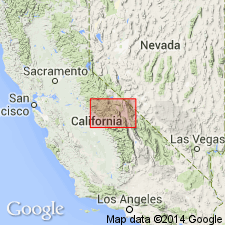
- Usage in publication:
-
- El Capitan Granite*
- Modifications:
-
- Revised
- AAPG geologic province:
-
- Sierra Nevada province
Summary:
Included in intrusive suite of Yosemite Valley. Here includes plutons referred to by different names: granodiorites of Double Rock and of Mount Hoffman (Kistler, 1973; Bateman and others, 1983), the granite of Gray Peak (Peck, 1980; 1983), and granites of Bald Mountain and of Swamp Lake (Dodge and Calk, 1986, 1987). Intrudes Bass Lake Tonalite (new) and granodiorite of Arch Rock of Fine Gold Intrusive Suite (new) and granite porphyry of Star Lakes. Intruded by granitoids that border on E. side. U-Pb ages of 103 and 102 Ma (Stern and others, 1981) indicate Early Cretaceous age.
Source: GNU records (USGS DDS-6; Menlo GNULEX).
For more information, please contact Nancy Stamm, Geologic Names Committee Secretary.
Asterisk (*) indicates published by U.S. Geological Survey authors.
"No current usage" (†) implies that a name has been abandoned or has fallen into disuse. Former usage and, if known, replacement name given in parentheses ( ).
Slash (/) indicates name conflicts with nomenclatural guidelines (CSN, 1933; ACSN, 1961, 1970; NACSN, 1983, 2005, 2021). May be explained within brackets ([ ]).

